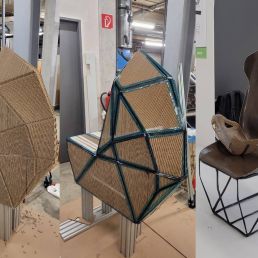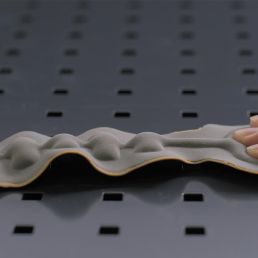Useful Particles
Functional surfaces based on nanoparticles
form 214
May/June 2007
publisher
Birkhäuser (Basel)

Silver, titanium, diamonds – materials from which, above all, jewelry used to be made. Today, they play an ever greater role in the high-tech industry and also for designers. Their nano-structures have such outstanding properties that they can be applied for a great variety of functions.
A nanometer is a billionth of a meter. At that level, for example, titanium dioxide particles prove to be veritable multitaskers. They have a dirt-dissolving effect, neutralize smells and toxins in the air and block UV radiation. As early as 2001, glass makers Pilkington blazed the trail, launching the first self-cleaning glass on the market – it goes by the name of “Active”. The glass is coated with titanium dioxide particles which in daylight destroy the chemical bond between particles of dirt. As no droplets form on this surface, water distributes itself over the glass in an extremely thin layer and flows off. This way cleaning costs can be cut for large facades and public transport vehicles. The latest model of the Japanese high-speed train, the Shinkansen N700, plying the Tokyo / Osaka route, for example, comes equipped with the titanium-dioxide surface. The new material fights not only grime but also the toxins found in the air. Hardly surprisingly, the first applications hail from Japan: titanium dioxide-covered wallpaper and screens. They have won a number of environmental prizes. Alpina’s new wall-paint AirClean has a similar effect. It uses the capabilities of titanium dioxide to improve the ambient air quality: The wall paint transforms fat smells and fumes into harm-less substances – an effect that endures for years.
Nano-silver has a highly anti-bacterial effect and is thus particularly suited for medical components such as scalpels or implants. The silver ions integrated into the surface also kill germs which are resistant to antibiotics, preventing life-threatening infections. One of the specialists in this field is Nuremberg-based company Bio-Gate, which applies nano-scale silver to various materials to achieve long-term protection against bacteria and other pathogens.
Carbon Nanotubes (CNT) are another excellent example of nanotechnology. Like diamonds, they are made up of carbon atoms. CNTs are extremely resilient, five times as stable as steel, and conduct electricity as effectively as copper. Highly resilient plastics can be manufactured with carbon nano-tubes which are suitable for sports equipment such as the baseball bat on our picture or lightweight components. The Fraunhofer Institute’s TEG or Technology Development Group has, for example, developed a CNT composite that enables you to heat the handles of chain-saws extremely quickly so that forest and construction workers do not suffer from frozen hands. Bayer MaterialScience in particular would like to establish itself as the leading manufacturer of CNT (Baytubes).
image: Baytubes (source: Bayer MaterialScience)
Ecoblaq molecular wood colours
23 March 2024
Ecoblaq is a molecule manipulation method, a natural chemical reaction, making…
Natural fiber reinforced car seat
22 October 2023
The focus of the project "Design for Recycling" is a seat shell that is made…
MotorSkins morphing textiles
19 April 2022
Berlin based start-up MotorSkins designs and produces textiles with embedded…
3D Pioneers Challenge 2022
15 December 2021
The 3D Pioneers Challenge 2022 adresses tech pioneers who pave the way for…
IGNIS – Light from waste heat energy
12 August 2020
The availability of affordable, independent and, above all, clean electrical…
Brake disc with reduced fine dust
21 April 2021
Fine dust endangers our health. One of the main sources is traffic, especially…
Texoversum
15 July 2023
With the "Texoversum", Reutlingen University has put into operation a training…
Invisible Terracotta Solar Rooftile
10 May 2023
The family-run business Dyaqua has developed a technology to integrate a…
Xarvio – Digital Farming
8 January 2021
BASF Digital Farming GmbH has received the renowned Crop Science Award for the…








